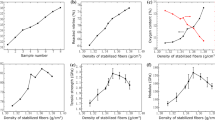Abstract
A commercial textile-grade acrylic fiber was modified with guanidine hydrochloride for the preparation of low-cost carbon fibers. Thermal behavior of the modified acrylic fiber was studied by simultaneous differential scanning calorimetry and thermogravimetric analysis, and the effect of guanidine hydrochloride on the thermal stabilization of acrylic fiber was investigated by Fourier transform infrared spectrometry and densimetry. The results indicated that guanidine hydrochloride could initiate the cyclization reaction of nitrile groups at lower temperature and promote the thermal stabilization of acrylic fiber. Compared with the carbon fibers prepared from the original acrylic fiber, the tensile strength and tensile modulus of the carbon fibers prepared from the modified acrylic fiber had been increased by about 72% and 34%, respectively. The guanidine hydrochloride-modified acrylic fiber was expected to be a practical low-cost carbon fiber precursor.










Similar content being viewed by others
References
Frank E, Steudle LM, Ingildeev D, Buchmeiser MR. Carbon fibers: precursor systems, processing, structure, and properties. Angew Chem. 2014;53(21):5262–98.
Krishnan GS, Murali N, Ahamed AJ. Structural transformation, thermal endurance, and identification of evolved gases during heat treatment processes of carbon fiber polymer precursors focusing on the stereoregularity. J Therm Anal Calorim. 2017;129(2):821–32.
Holmes M. Global carbon fibre market remains on upward trend. Reinf Plast. 2014;58(6):38–45.
Serkov AT, Radishevskii MB. Status and prospects for production of carbon fibres based on polyacrylonitrile. Fibre Chem. 2008;40(1):24–31.
Warren CD, Das S, Wheatley DA. Low cost carbon fibre for automotive applications part 1: low cost carbon fibre development. 2014. https://www.osti.gov/biblio/1154766.
Wheatley A, Warren D, Das S. Development of low-cost carbon fibre for automotive applications. New York: Wiley; 2014.
Warren CD, Wheatley DA, Das S. Low-cost carbon fibre: applications, performance and cost models—chapter 17. 2014. https://www.osti.gov/biblio/1154767.
Paulauskas FL, Warren CD, Eberle CC, Naskar AK, Ozcan S, et al. Novel precursor materials and approaches for producing lower cost carbon fiber for high volume industries. Automot Appl Recycl Edimburgo [sn]. 2009. http://www.iccmcentral.org/Proceedings/ICCM17proceedings/Themes/Industry/AUTO%20APPLI%20%20RECYC/A3.6%20Paulauskas.pdf.
Sedghi A, Farsani RE, Shokuhfar A. The effect of commercial polyacrylonitrile fibers characterizations on the produced carbon fibers properties. J Mater Process Technol. 2008;198(1–3):60–7.
Baker DA, Gallego NC, Baker FS. On the characterization and spinning of an organic-purified lignin toward the manufacture of low-cost carbon fiber. J Appl Polym Sci. 2012;124(1):227–34.
Yan X, Zhou W, Zhao X, Xu J, Liu P. Preparation, flame retardancy and thermal degradation behaviors of polyacrylonitrile fibers modified with diethylenetriamine and zinc ions. J Therm Anal Calorim. 2016;124(2):719–28.
Bikshapathi M, Verma N, Singh RK, Joshi HC, Srivastava A. Preparation of activated carbon fibers from cost effective commercial textile grade acrylic fibers. Carbon Lett. 2011;12(1):44–7.
Nabais J, Carrott P, Ribeiro Carrott M. Preparation of activated carbon fibres from acrylic textiles fibres. Carbon. 2001;39(10):1543–55.
Nabais JMV, Carrott PJM, Carrott MMLR. From commercial textile fibres to activated carbon fibres: chemical transformations. Mater Chem Phys. 2005;93(1):100–8.
Xue Y, Liu J, Lian F, Liang JY. Effect of the oxygen-induced modification of polyacrylonitrile fibers during thermal-oxidative stabilization on the radial microcrystalline structure of the resulting carbon fibers. Polym Degrad Stab. 2013;98(11):2259–67. https://doi.org/10.1016/j.polymdegradstab.2013.08.016.
Li Y, Cui D, Tong Y, Xu L. Study on structure and thermal stability properties of lignin during thermostabilization and carbonization. Int J Biol Macromol. 2013;62(11):663–9.
Xue Y, Liu J, Liang JY. Correlative study of critical reactions in polyacrylonitrile based carbon fiber precursors during thermal-oxidative stabilization. Polym Degrad Stab. 2013;98(1):219–29. https://doi.org/10.1016/j.polymdegradstab.2012.10.018.
Xiao SJ, Wang B, Zhao C, Xu LH, Chen BH. Influence of oxygen on the stabilization reaction of polyacrylonitrile fibers. J Appl Polym Sci. 2013;127(3):2332–8. https://doi.org/10.1002/app.37930.
Ngoc UNT, Hong SC. Structural evolution of poly(acrylonitrile-co-itaconic acid) during thermal oxidative stabilization for carbon materials. Macromolecules. 2013;46(15):5882–9. https://doi.org/10.1021/ma401003g.
Munteanu BS, Brebu M, Vasile C. Thermal behaviour of binary and ternary copolymers containing acrylonitrile. Polym Degrad Stab. 2013;98(9):1889–97. https://doi.org/10.1016/j.polymdegradstab.2013.04.018.
Rahaman MSA, Ismail AF, Mustafa A. A review of heat treatment on polyacrylonitrile fiber. Polym Degrad Stab. 2007;92(8):1421–32. https://doi.org/10.1016/j.polymdegradstab.2007.03.023.
Ko TH, Chiranairadul P, Ting HY, Lin CH. The effect of modification on structure and dynamic mechanical behavior during the processing of acrylic fiber to stabilized fiber. J Appl Polym Sci. 2010;37(2):541–52.
Mathur RB, Gupta D, Bahl OP, Dhami TL. Infrared spectral studies of preoxidized PAN fibres incorporated with cuprous chloride additive. Fibre Sci Technol. 1984;20(3):227–34.
Ko TH, Huang LC. Preparation of high-performance carbon fibres from PAN fibres modified with cobaltous chloride. J Mater Sci. 1992;27(9):2429–36.
Mathur RB, Mittal J, Bahl OP, Sandle NK. Characteristics of KMnO4-modified PAN fibres—its influence on the resulting carbon fibres’ properties. Carbon. 1994;32(1):71–7.
Ju A, Xu H, Ge M. Preparation and thermal properties of poly[acrylonitrile-co-(β-methylhydrogen itaconate)] used as carbon fiber precursor. J Therm Anal Calorim. 2014;115(2):1037–47.
Ouyang Q, Wang X, Wang X, Huang J, Huang X, Chen Y. Simultaneous DSC/TG analysis on the thermal behavior of PAN polymers prepared by aqueous free-radical polymerization. Polym Degrad Stab. 2016;130:320–7.
Ouyang Q, Cheng L, Wang HJ, Li KX. DSC study of stabilization reactions in poly(acrylonitrile-co-itaconic acid) with peak-resolving method. J Therm Anal Calorim. 2008;94(1):85–8.
Shimada I, Takahagi T, Fukuhara M, Morita K, Ishitani A. FT-IR study of the stabilization reaction of polyacrylonitrile in the production of carbon fibers. J Polym Sci Part A Polym Chem. 1986;24(8):1989–95. https://doi.org/10.1002/pola.1986.080240819.
Ouyang Q, Lu C, Wang H, Li K. Mechanism and kinetics of the stabilization reactions of itaconic acid-modified polyacrylonitrile. Polym Degrad Stab. 2008;93(8):1415–21.
Grove III DA, Abhiraman AS. A mathematical model of solid-state thermo-oxidative stabilization of acrylic fibers. Carbon. 1992;30(3):451–7. https://www.sciencedirect.com/science/article/pii/000862239290043V.
Acknowledgements
National Key Research and Development Plan of China (2016YFB0101702) is gratefully acknowledged for the financial support.
Author information
Authors and Affiliations
Corresponding author
Rights and permissions
About this article
Cite this article
Huang, J., Ouyang, Q., Li, M. et al. Thermal behavior and thermal stabilization of guanidine hydrochloride-modified acrylic fiber for preparation of low-cost carbon fiber. J Therm Anal Calorim 136, 2195–2203 (2019). https://doi.org/10.1007/s10973-018-7848-9
Received:
Accepted:
Published:
Issue Date:
DOI: https://doi.org/10.1007/s10973-018-7848-9




